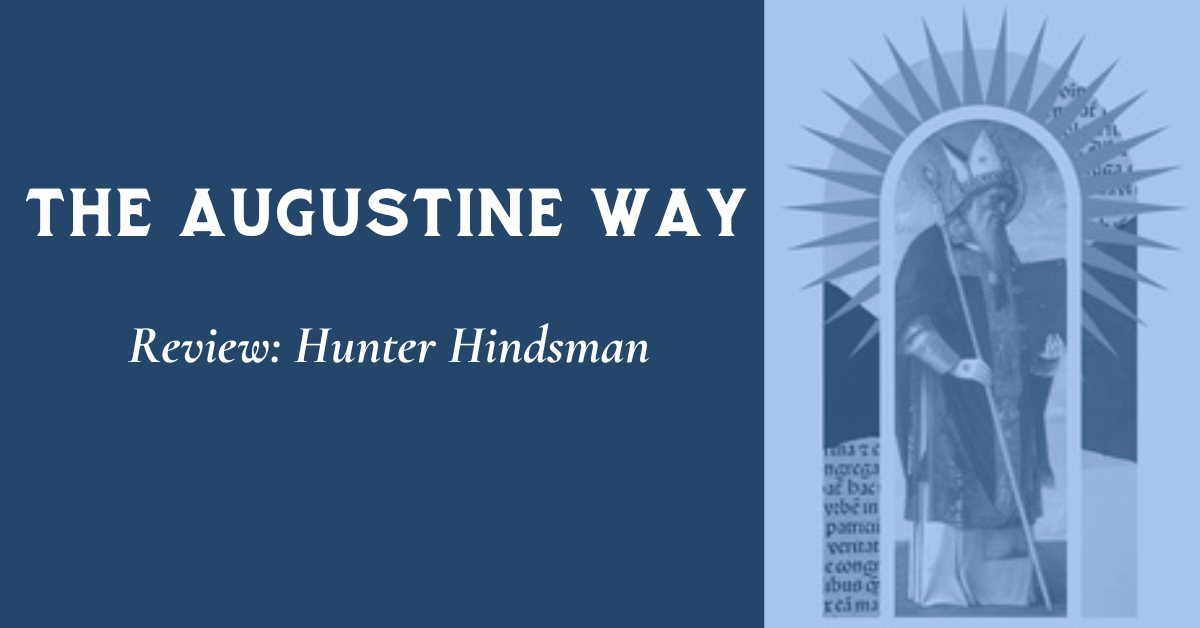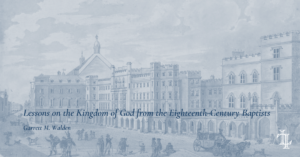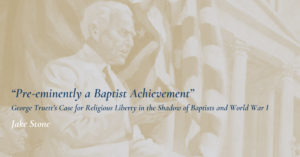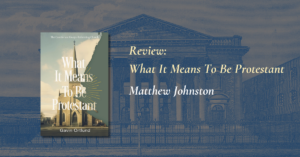Chatraw, Joshua D. and Mark D. Allen. The Augustine Way: Retrieving a Vision for the Church’s Apologetic Witness. Grand Rapids: Baker Academic, 2023. 197 pp. $24.99.
“‘What do you call an amateur theologian?’
‘An Apologist.’
Though that joke might get some laughs around a table of theologians today, Augustine, along with the rest of the church fathers, wouldn’t get it. Allowing Augustine to speak into contemporary apologetics might just change the way pastors and missionary church planters see the discipline and imagine their place in it.” (68)
Dissatisfied with the state of contemporary apologetics, Joshua Chatraw and Mark Allen “hope to recover ancient wisdom to meet the challenges of our day with theological faithfulness and renewed apologetic imaginations” (2). To accomplish this, The Augustine Way looks to the model set by Augustine in Confessions and The City of God. They are not concerned with repristinating Augustine’s philosophy nor returning to a supposed golden age of premodernity. Rather, “if we benefit from the Augustine we have met in this project,” they explain, “he will have helped us through the storm of secularism,” not providing “a spot to land on” but offering “us a trajectory . . . to follow, resources to build on, and a rhetorical strategy flexible enough to be employed in different contexts” (172–74). In other words, they are hoping to retrieve the spirit, not the letter, of Augustine for the sake of persuading those in our current context “to enter the blessed city of God” (184).
Their work is divided into two parts. In Part One, they introduce Augustine and survey the land of contemporary apologetics, critiquing current approaches’ inadequacy to persuade those in our late modern context.1On the usage of the term “late modern,” Chatraw and Allen explain: “While we do not dispute the questionable value of the label ‘postmodern’ itself (the label has the potential of at times concealing more than it reveals), in common usage it is at least nominally communicating some general societal shifts. Granted, most would admit that modernity is alive and well within postmodernity (or whatever one decides to call it) and that a kind of pre-postmodernity already existed within modernity in various forms, such as Romanticism; but few would deny that some kind of shift has happened with the rise of Jacques Derridas ‘deconstructionism,’ Jean-François Lyotard’s ‘incredulity toward metanarratives,’ and Michel Foucault’s ‘power-knowledge.’ We prefer the designation ‘late modern,’ because it recognizes the complexity of an epochal change while acknowledging that with such a shift there are always continuities and discontinuities.” (42-43) In Part Two, they examine Augustine’s apologetic method and put forth their vision for a holistic, therapeutic approach. Chatraw and Allen are less concerned with the disciplinary means of objectively grounding the truth claims of Christianity based on rational argumentation and evidence; they are most concerned with apologetics as persuasion.2I am indebted to Matt Ntiros for his helpful feedback and assistance in this review and for this particular observation.
In this review, I unpack their critiques, the nature of their apologetic approach, and their methodology, evaluating the merit of their work along the way. In the end, while I have quibbles with aspects of The Augustinian Way and its approach, I conclude that this book is a helpful conversation starter for pastors and apologists seeking to engage both the lost and those in the pews.
Critiquing Contemporary Apologetics
In their second chapter, Allen recalls his apologetics course with Norman Geisler, in which Geisler presented a semester-long case that “seemed at the time to be an airtight argument for the Christian faith” (35). Yet when Allen sought to implement Geisler’s approach in his pastorate, he found it to lack “an awareness of the contingencies in how different people reason” and thus yielded an approach that was “insufficiently contextual and anthropologically thin” (37). In fact, they conclude that “the most popular apologetic approaches today lack an integrative model—a way of doing apologetics—that is responsive to cultural and historical variances and, in the words of Charles Taylor, our social imaginaries” (37).
The authors define social imaginary as that which “consists of pre-reflective assumptions that shape our loves, provide the framework for what is believable and what is unbelievable, and contribute to the context for which arguments and evidence are meaningful and which are insubstantial and unconvincing” (37-38). Contemporary apologetics, in their view, “still give only a polite nod, if that, to the social imagination of late moderns. By doing so, they risk bypassing the way people navigate their life and imagine the world to be” (39). They believe apologists, such as William Lane Craig on the one hand or Scott Oliphint on the other, do not go far enough in their integration of “cultural analysis into an apologetic approach” and thus are crafting arguments based on a “faulty epistemology” for an epoch that is fading away (42, 49).
Specifically, the authors take issue with the assumption of a “universal, common-sense rationality” that does not consider the ways in which “larger conceptions of rationality are dependent not only on basic logic but also on the evidence available at a particular time and the shifting social imaginaries or assumed metanarratives of different social milieus” (49). In this usage, Chatraw and Allen are not denying objective absolutes that can be perceived by a universal rationality grounded in the image of God. Rather, they reject the idea that there exists a universal way of reasoning. They unpack this claim a bit more by explaining that:
We affirm that God, the transcendent and objective Logos, holds all things together as the universal and personal rationality; yet as finite and contingent beings, our particular social and historical locations cannot be bypassed in our attempt to access this rationality. Yet when our contingency is tacitly seen as a barrier to truth rather than an inescapable feature by which humans must discern truth, there seems to be less incentive to build into our apologetic models the resources needed to read and engage with shifting cultural landscapes. . . . A more nimble and holistic approach would be willing to leverage wholeheartedly the historical, theological, and existential evidence for the resurrection, as Augustine himself did, as reasons for believing in the resurrection (49–50).
Augustine, in their view, provides such a nimble and holistic approach to which I now turn.
The Augustine Way
According to the authors, the classical approach to apologetics overemphasizes humans as thinkers, the presuppositional/covenantal approach overemphasizes people as believers, whereas what is needed is an apologetic that treats humans as thinkers, believers, and lovers (to borrow from James K.A. Smith’s taxonomy) (53). Such an integrated view of the human person will be what yields an apologetic approach that “captures the imagination of the late modern” with “content and forms that are aimed at the ‘gut’ and the ‘head’ together” (54). Confessions and The City of God display Augustine’s way of doing apologetics, which consists of the following three aspects of the Augustine Way: (1) its posture of humility, (2) its ecclesial pilgrimage, and (3) its therapeutic approach.
Holding up the famed opening paragraph of Confessions as indicative of Augustine’s posture, Chatraw and Allen see Augustine offering a “realistic rationality that humbly accepts its own limits and lets go of a false belief that through a type of technological precision we can achieve guaranteed right beliefs” (82). Augustine embraced a posture that did not seek to lead others to epistemic certainty, but to help them learn to ask better questions with the humility of not knowing all the answers as they reasoned from faith in their journey “toward eternal rest in God” (84–85). Augustine first wanted to move one from pride to humility. He did not believe a person must first adopt a Christian worldview . . . before they can reason or consider evidence;” rather, he used logic, history, and evidence to make his case recognizing how one’s posture was shaped by the dominant cultural forces affected the way in which one reasoned (93). In narrating both his experience and a truer history, Augustine was able to demonstrate God’s truth in such worldviews while also exposing their deficiencies for the purpose of encouraging others to embrace the catholic faith. Chatraw and Allen explain:
Augustine models for his congregants a critical appropriation of cultural currents in order to help them live out their faith in their everyday existence. By finding points of agreement and pointing out areas of difference, Augustine used Platonism to help his congregants make sense of their late fourth-century and early fifth-century questions, longings, and pressures. . . . Even though Platonism fails to take us to the promised land, it is born out of human longing for home. Augustine critiques Platonism but also leverages it for Christian instruction and culturally aware persuasion. . . . Sometimes it’s tempting (and pleases our Christian base) to simply try and burn rivals to the ground rather than explore what might be apologetically salvageable in their beliefs, excavating to expose foundational posts still standing amid the debris, pointing beyond themselves to the triune God. Augustine wisely models for us the latter. (95–97)
Having established the Augustinian posture, Chatraw and Allen discuss the church’s status as pilgrims in this world:
It was Augustine’s spiritual and theological formation within the ecclesia that gave him both the diagnostic skill and the cruciform posture needed to offer the church and the world his more expansive, public vision of Christianity’s counternarrative, spanning from creation to consummation. (104)
The apologist ought to expose the illness of various social imaginaries and offer the healing of Christ available in his church that would not be realized in this age. The church is the counter society that reorients her members to the coming kingdom, while also equipping them “with the diagnostic tools to see into society’s idolatry and forming us into a source of healing and hope for our neighbors” without falling prey to overrealized eschatologies (122). Parachurch and YouTube Apologists fail to meet the growing discontentment of the age since they are far too often disconnected from the “community living out the drama of the gospel and thereby serving as a hospital for the restoration of broken and rebellious image bearers” (126).
Lastly, in Chapter Five, Chatraw and Allen put forth their therapeutic approach that affirms universal human rationality but recognizes “the contingency of human rationality, the finitude of our interpretations of the world, and the impact of sin” (137). Specifically, Augustine is able to provide this model since he had the “goal of moving the reader—his mind, beliefs, and affections—toward God, and they employ story as the governing framework for doing so” (141). In other words, they advocate for a narrative apologetic that “out-narrates” rather than merely out-logics the dominant social imaginaries of the day. This model can be broken down into two steps.
The first step, as modeled in Books 1–8 of Confessions and the first half of City of God, can be seen in how Augustine used a layered narrative that “deconstructed” the predominant counter-narratives to demonstrate how each lacked “coherence, explanatory power, or the ability to make good on its claims and aspirations” (149, 154). In other words, Augustine reasoned within the culture to show that his opponents still stood on faith, but a faith that failed to deliver on life’s big questions. Augustine’s goal in this was not to annihilate, but, like a doctor doing exploratory surgery, to show the problem for the sake of their healing. “For, while Augustine uses their philosophy, he uses it to help prepare them to see that the best of their philosophy promises what only Christ can deliver” (156)—which is the second step. Augustine invited others to journey on the Christian way and receive the healing only found in Christ. Chatraw and Allen helpfully distill the Augustine Way for apologetics in this simple paragraph:
Augustine (step 1a) speaks within his culture’s dominant narratives so he can be understood, (step 1b) speaks against these same stories to show they are deficient even on their own terms and are ultimately insufficient for those who rely on them, and (step 2a) redirects them toward Christ and the biblical story while (step 2b) offering positive support and responding to critics along the way. (160).
This two-step apologetic therapeutic approach carried out with a posture of humility within the ecclesial community is the apologetic method to which Chatraw and Allen are calling pastors and apologists. It is, in their view, The Augustine Way that ought to be retrieved.
Not Your Typical History
The authors make clear in their introduction that “In carrying out this apologetic retrieval, our organizing questions do not locate us primarily in the past but rather place Augustine in our present age, that he might speak to us in ways that are resonant. . . . This is an imaginative enterprise through which we ask, If Augustine were here with us, what might he say?” (1).
Now, any historian knows one of the laws of history to be David Lowenthal’s maxim: “The past is a foreign country. They do things differently there.”3Quoted in John Fea, Why Study History? Reflecting on the Importance of the Past (Grand Rapids: Baker Academic, 2013), 48. The truth of the matter is: We are not sure what Augustine would say today if he were here with us. Thus, while this work offers a fine historical evaluation of Augustine’s context and the texts he produced within such contexts, it—self-consciously—goes beyond what a historian qua historian can affirm and ought to be evaluated as such. Their main goal is not to merely describe what Augustine was doing, but to abstract timeless truths from Augustine that point us in the right direction in this apologetic enterprise.
The danger of such an imaginative ressourcement is that, at times, too neat a line is drawn from the past to the present—which does lend this work to a few friendly critiques. First, the authors portray the Manicheans—adherents to a latter expression of Gnosticism4See the introduction in: Augustine, Confessions, trans. R. S. Pine-Coffin, Penguin Classics (London: Penguin Books, 1982), 13–14.—in a manner that is meant to implicitly condemn post-enlightenment rationality supposedly represented by classical approaches. However, such a comparison is historically inaccurate and unwarranted, for not all contemporary classical approaches to apologetics are rooted in post-enlightenment rationality. The Manicheans were not the ones solving the mysteries according to “science and reason” (80); in the end, Augustine was promoting what accorded with science and reason. In the same way, the authors could have been clearer in distinguishing the premodern Augustine from the thinkers of late modernity. There are a lot of developments that took place in the twentieth century which led to the linguistic turn’s emphasis on situatedness, contingent ways of reasoning, and the shaping power of narrative.5Elizabeth A. Clark, History, Theory, Text: Historians and the Linguistic Turn (Cambridge, MA: Harvard University Press, 2004). As a postmodern thinker herself, these developments are helpfully traced by Elizabeth Clark in this work on historiography and the linguistic turn. Some of these developments rejected truths Augustine held dear. As in hermeneutical developments, we ought to be careful to distinguish between a premodern and a late modern or postmodern approach.
Second, in their emphasis on holistic anthropology, they overemphasize the similarity between Augustine’s unique brand of substance dualism and the more recent anthropologies that give more emphasis on embodiment. So, while Augustine did believe “the human body [to be] a revelation of the goodness of God” and vehemently denied that its nature is evil, he did locate the impetus of identity in the soul, admitting that the body can be “a burden on our soul” and is subordinated to needs of the “rational soul.”6ugustine, Augustine in His Own Words, ed. William Harmless (Washington, D.C: Catholic University of America Press, 2010), 346–47, 369. See also, Augustine, On Christian Teaching, trans. R. P. H. Green, Oxford World’s Classics (Oxford: Oxford University Press, 2008), 16. Their “thinker, believer, and lover” taxonomy provided by James K.A. Smith can be helpful. However, this work relies heavily on anthropological convictions, while avoiding the major questions regarding how the rational soul relates to the body and its implications for apologetics. As such, in their criticisms of anthropologies that overemphasize rationality, they at times critique anthropological convictions Augustine himself held.
Lastly, in their nuanced and reserved affirmation of the concept of universal human rationality, they locate Augustine closer to the twentieth-century genealogists than the primary texts will allow. Augustine recognized how one’s cultural situatedness could lead others astray based on various superstitions they believed;7Augustine, On Christian Teaching, 49–54. however, he was confident that:
God infused into human life a capacity for reasoning and understanding. . . . Over the course of years it awakens into a life that involves learning and education, the perception of the true, and the pursuit of the good. This capacity flowers into that wisdom and virtue that enable the soul to battle with the arms of prudence, fortitude, temperance, and justice against error, waywardness, and other inborn weaknesses, and to conquer them with a purpose that is none other than that of reaching the supreme and immutable Good. Even when this Good is not attained, there still remains, rooted in all rational nature, a God-given capacity for goods so high that the wonders of God’s omnipotence are beyond any tongue to express or any mind to comprehend.8Augustine, Augustine in His Own Words, 368.
On this concept, Augustine grounded his persuasive enterprise. He claimed that Christ is “the Wisdom that every rational soul does indeed consult . . . therefore, even when I speak what is true and one sees what is true, it is not I who teach you. For one is being taught not by my words but by the realities themselves made manifest by the enlightening action of God from within.”9Augustine, Augustine in His Own Words, 70. Thus, with more nuance than offered by Chatraw and Allen on the role of universal rationality in Augustine, Ronald Nash has explained that Augustine’s understanding of reason was not uniform. Rather,
Augustine distinguished between the ratio superior and ratio inferior, the higher and lower reasons. These two aspects of the same mind have different objects, methods, ends, and results. The object of the lower reason is the temporal world of particulars; its method is investigation; its end is action; and its result is scientia. The object of the higher reason is the eternal world of the forms; its method is contemplation; its end is happiness; and its result is sapientia. Intellectus is a faculty of the mind above reason, specifically above ratio inferior. It is that part of the soul illumined by the divine light.10Ronald H. Nash, ed., The Light of the Mind: St. Augustine’s Theory of Knowledge (Lima, OH: Academic Renewal Press, 2003), 65.
Thus, in some ways, Augustine’s apologetic approach did embrace human limitation by acknowledging dominant cultural lies that affect the seeker, but in other ways, he significantly elevated the human intellect via mankind’s universal capacity for rational participation in the “eternal ideas in the mind of God.”11Nash, 5.
In the end, the substance of each of my critiques is that this work, at times, falls prey to the dangers to which any project of ressourcement is subject: the danger in which the good and bad guys of the past suspiciously resemble the “good” and “bad” guys of the present.
Nevertheless, I believe the approach put forth in The Augustine Way is the right one. While Chatraw and Allen perhaps are too critical of logic, analytic precision, and syllogistic argumentation, they are correct in their contention that apologetics ought to include yet involve much more than such things—something to which many devoted classical apologists would say “yes and amen!” Their emphasis on epistemic humility and the importance of the church and its liturgy for apologetics is a welcome one. While some might take issue with the manner of their critique of classical and presuppositional apologetics, the point remains that the way forward must be able to leverage all the evidence without neglecting how poignant cultural analysis of the dominant social imaginaries can be.
Here, Chatraw and Allen are right to hold up Augustine as a model to follow. Their analysis of both Confessions and City of God’s apologetic witness is helpful not only to pastors and apologists but also to those seeking to better understand how the early church situated themselves to the broader philosophical cultures of the day. Augustine provides a model for engaging the philosophical milieus of the day that does not pine for days gone by but seeks to engage late modern people with late modern arguments, identify how they are truly longing for God, and show them that what they long for is found in what Justin Martyr described as the surest philosophy.
The Augustine Way provides a helpful starting place for reflection. It does not offer all the answers. And, like me, you may have certain quibbles here and there historically or even methodologically. However, I believe it to be a worthwhile book that sets its reader on the right path as they seek to engage the lost not to destroy them but that they might be saved from their rebellion and experience the healing only Christ can provide.
I recall a time not too long ago when I was sitting on the beach with a friend who also was a skeptic of the faith. We had time, and he wanted to dialogue. So, we did. After a few hours of this and having exhausted all the logical arguments I could muster, I finally asked, “Let’s say for the sake of argument, I convinced you beyond a reasonable doubt that Jesus rose from the grave and Christianity was true, would you become a Christian today?” His answer was simple and to the point: “No.” After that, we agreed to enjoy the weekend with our group of friends, and it did not come up again. However, as a pastor that conversation has stuck with me as a reminder that apologetics is much more than logical argumentation. There’s always more underneath, and Augustine had a way of getting to the stuff underneath.
We would do well to follow in his footsteps, and this work will help you do so.
[1] On the usage of the term “late modern,” Chatraw and Allen explain: “While we do not dispute the questionable value of the label ‘postmodern’ itself (the label has the potential of at times concealing more than it reveals), in common usage it is at least nominally communicating some general societal shifts. Granted, most would admit that modernity is alive and well within postmodernity (or whatever one decides to call it) and that a kind of pre-postmodernity already existed within modernity in various forms, such as Romanticism; but few would deny that some kind of shift has happened with the rise of Jacques Derridas ‘deconstructionism,’ Jean-François Lyotard’s ‘incredulity toward metanarratives,’ and Michel Foucault’s ‘power-knowledge.’ We prefer the designation ‘late modern,’ because it recognizes the complexity of an epochal change while acknowledging that with such a shift there are always continuities and discontinuities.” (42-43)
[2] I am indebted to Matt Ntiros for his helpful feedback and assistance in this review and for this particular observation.
[3] Quoted in John Fea, Why Study History? Reflecting on the Importance of the Past (Grand Rapids: Baker Academic, 2013), 48.
[4] See the introduction in: Augustine, Confessions, trans. R. S. Pine-Coffin, Penguin Classics (London: Penguin Books, 1982), 13–14.
[5] Elizabeth A. Clark, History, Theory, Text: Historians and the Linguistic Turn (Cambridge, MA: Harvard University Press, 2004). As a postmodern thinker herself, these developments are helpfully traced by Elizabeth Clark in this work on historiography and the linguistic turn.
[6] Augustine, Augustine in His Own Words, ed. William Harmless (Washington, D.C: Catholic University of America Press, 2010), 346–47, 369. See also, Augustine, On Christian Teaching, trans. R. P. H. Green, Oxford World’s Classics (Oxford: Oxford University Press, 2008), 16.
[7] Augustine, On Christian Teaching, 49–54.
[8] Augustine, Augustine in His Own Words, 368.
[9] Augustine, 70.
[10] Ronald H. Nash, ed., The Light of the Mind: St. Augustine’s Theory of Knowledge (Lima, OH: Academic Renewal Press, 2003), 65.
[11] Nash, 5.
Author
-

Hunter Hindsman is a pastor at MeadowBrook Church in Gadsden Alabama. He has received his Masters of Divinity from SWBTS and is a current Ph.D. candidate in the Historical and Theological Studies program at SBTS where he is focusing on early church history. He serves as the patristic theology editor for the London Lyceum. He’s married to his wife, Taylor, and is the father of Joanna, Mason, Jack, and Melanie.
View all postsRecent Posts



